A strong digital marketing strategy aligns every channel (like content, SEO, PPC, and social media) with your business goals. Landing pages play a key role in this setup. They help turn campaign clicks into conversions and ensure your efforts lead somewhere meaningful.
This article explores the main types of digital marketing, including content marketing, paid ads, and social media, and shares practical insights to improve your approach. When these strategies work together, they build a cohesive plan that supports long-term growth.
As Cameron McIver puts it, “An effective marketing plan links what the business wants to deliver with what the customer needs.” That connection is at the heart of every good strategy. By using tools like landing pages and customer data, you can create digital campaigns that truly move your business forward.
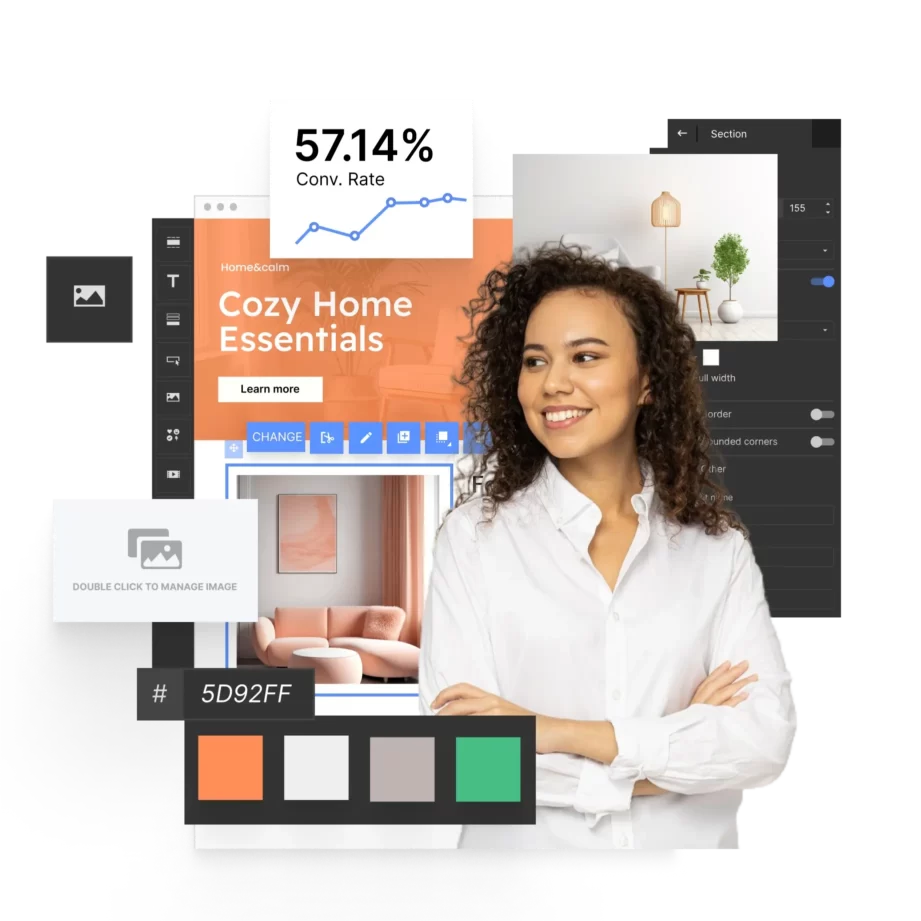
What is Digital Marketing Strategy?
A digital marketing strategy is a clear plan for how a business will use online channels to meet its goals. It helps teams stay focused by linking business objectives to specific online actions.
This plan outlines which digital tools you’ll use to reach people – like search engines, email, social platforms, and websites. It defines what you want to achieve and maps out how to get there step by step.
Every part of the plan works together. That means no single tactic stands alone. The strategy keeps all efforts consistent and heading in the same direction. Without a strategy, digital marketing can feel scattered and reactive. With one, it becomes focused, efficient, and easier to measure.
No more scattered efforts. Add focused, goal-driven landing pages that align with your digital strategy from day one.
9 Key Types of Digital Marketing Strategies
The key types of digital marketing strategies are content marketing, SEO, email marketing, PPC advertising, SEM, social media marketing, influencer marketing, CRO, and omnichannel marketing. Understanding different online marketing strategies, their objectives, and how to measure their success is crucial for creating an effective overall plan. Below, we’ll break down 9 marketing strategies, explaining the key components and how to ensure they are implemented effectively.
1. Content Marketing
Content marketing means creating and sharing useful content to attract and engage a specific audience. It includes more than just blog posts: think videos, infographics, podcasts, case studies, and social media updates. Every piece should offer value and quietly support your brand message.
Done right, content marketing builds trust and keeps your brand top of mind. It encourages repeat visits and helps turn attention into action. Content also shows your expertise without directly selling.
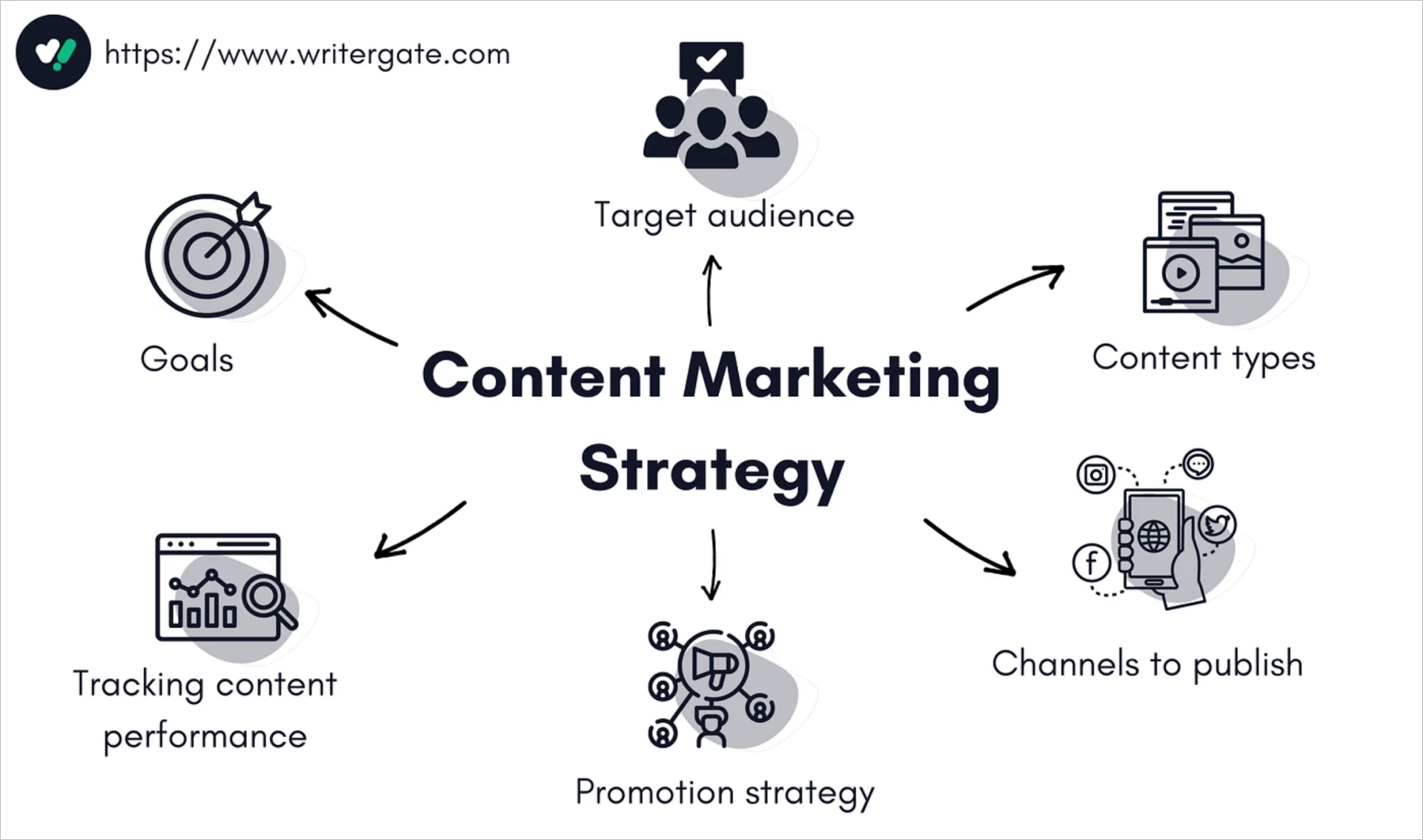
Objective
The goal is to attract, inform, and convert people by giving them content that’s useful and relevant to their needs.
Tactics
You can use blog articles, how-to videos, white papers, case studies, infographics, and short-form posts. The best content speaks directly to your audience’s questions or problems. It should help them while showing how your brand fits into their solution.
Success Factors
To succeed, you need to know your audience well and create content they care about. Use a content calendar to stay organized and consistent. Make sure your content is high-quality and easy to find on the platforms your audience prefers.
Measurement
Track success through metrics like page views, time on site, social engagement, lead quality, and conversion rates. These numbers show how well your content is working and where to improve.
Add landing pages to your content strategy and guide your readers straight to action.
2. SEO
SEO helps your website appear higher in search results so more people can find your content. It includes improving your site’s structure, using the right keywords, and earning links from other trusted websites. Strong SEO brings steady, unpaid traffic from search engines like Google.
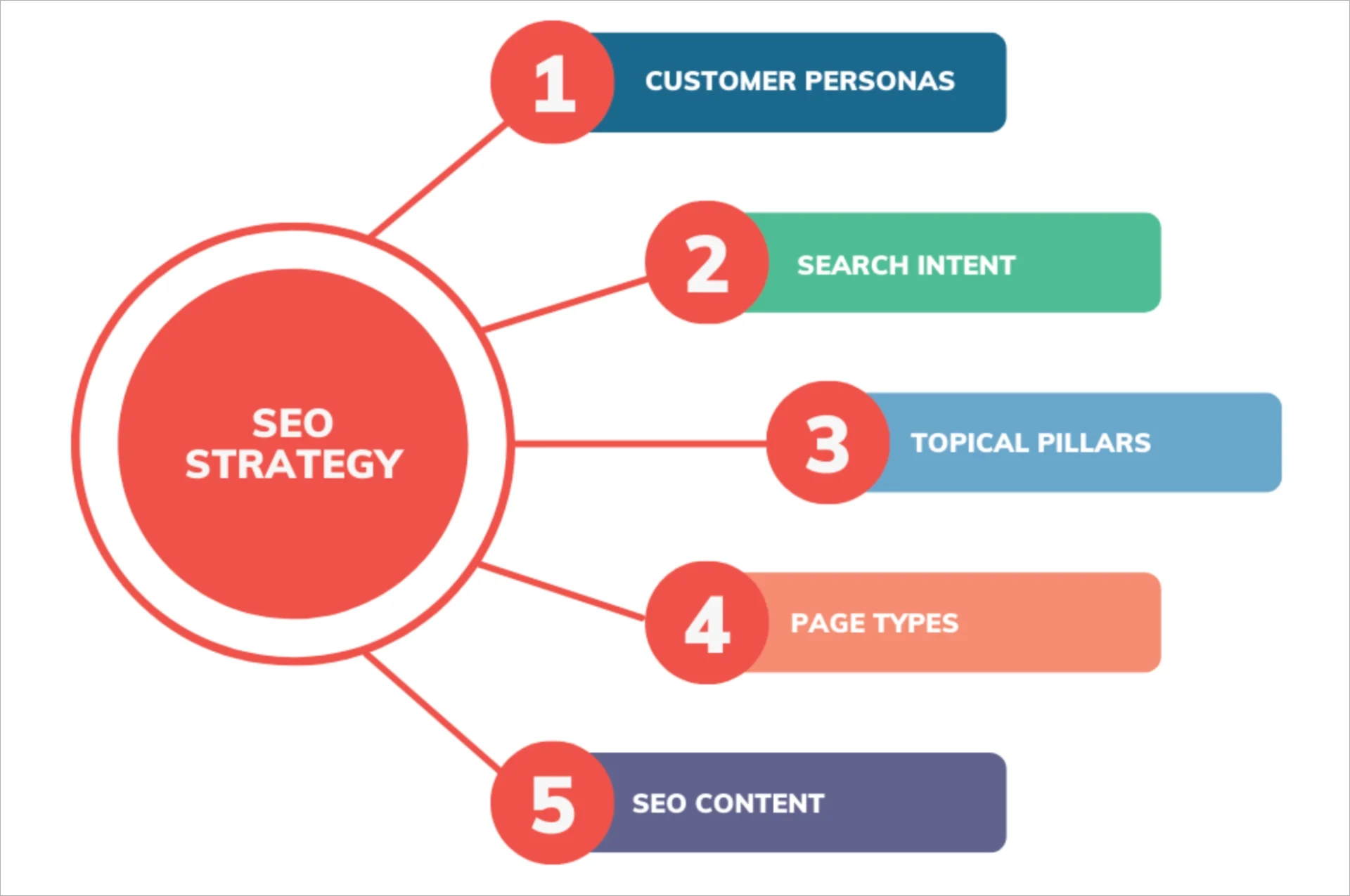
Objective
The goal of SEO is to improve your rankings for keywords your audience is searching for, increasing visibility and clicks.
Tactics
On-page SEO tactics include using keywords in titles, headings, and page content. Off-page SEO focuses on earning links from other trusted websites. Technical SEO improves how search engines crawl your site by fixing loading speed, mobile usability, and internal linking.
Success Factors
Success depends on choosing the right keywords, writing useful content, and keeping your site technically clean. Earning backlinks from strong sources and updating content over time also improves performance.
Measurement
Measure SEO by tracking organic traffic, search rankings, bounce rate, page speed, and backlink quality. These numbers show if your efforts are helping people find and stay on your site.
3. Email Marketing
Email marketing sends targeted messages to specific groups of people who’ve signed up to hear from you. It helps build loyalty, boost sales, and keep your brand in front of your audience. Personalized emails (like updates, offers, and reminders) can lead to repeat business and better customer relationships.

Objective
The main goal of email marketing is to build stronger relationships through personalized messages that lead to action.
Tactics
Use newsletters, limited-time offers, welcome sequences, abandoned cart emails, and tailored product suggestions. Segment your list based on user behavior, preferences, or purchase history. This makes each message more relevant and more likely to perform well.
Success Factors
Timing, relevance, and personalization are key. Segment your list so that people only get what matters to them. Test subject lines, layout, and calls-to-action to see what works best. Regular testing improves results over time.
Measurement
Track open rates, click-through rates, unsubscribes, conversions, and campaign ROI. These metrics help you understand what’s working and where to adjust.
Email marketing works best when it lands right. Use tailored landing pages to turn opens into action—and clicks into customers.
4. PPC Advertising
PPC advertising sends targeted traffic to your website through paid ads on search engines and social platforms. You pay only when someone clicks the ad, making it a cost-effective way to get immediate results. It works well alongside SEO to cover both short- and long-term goals.
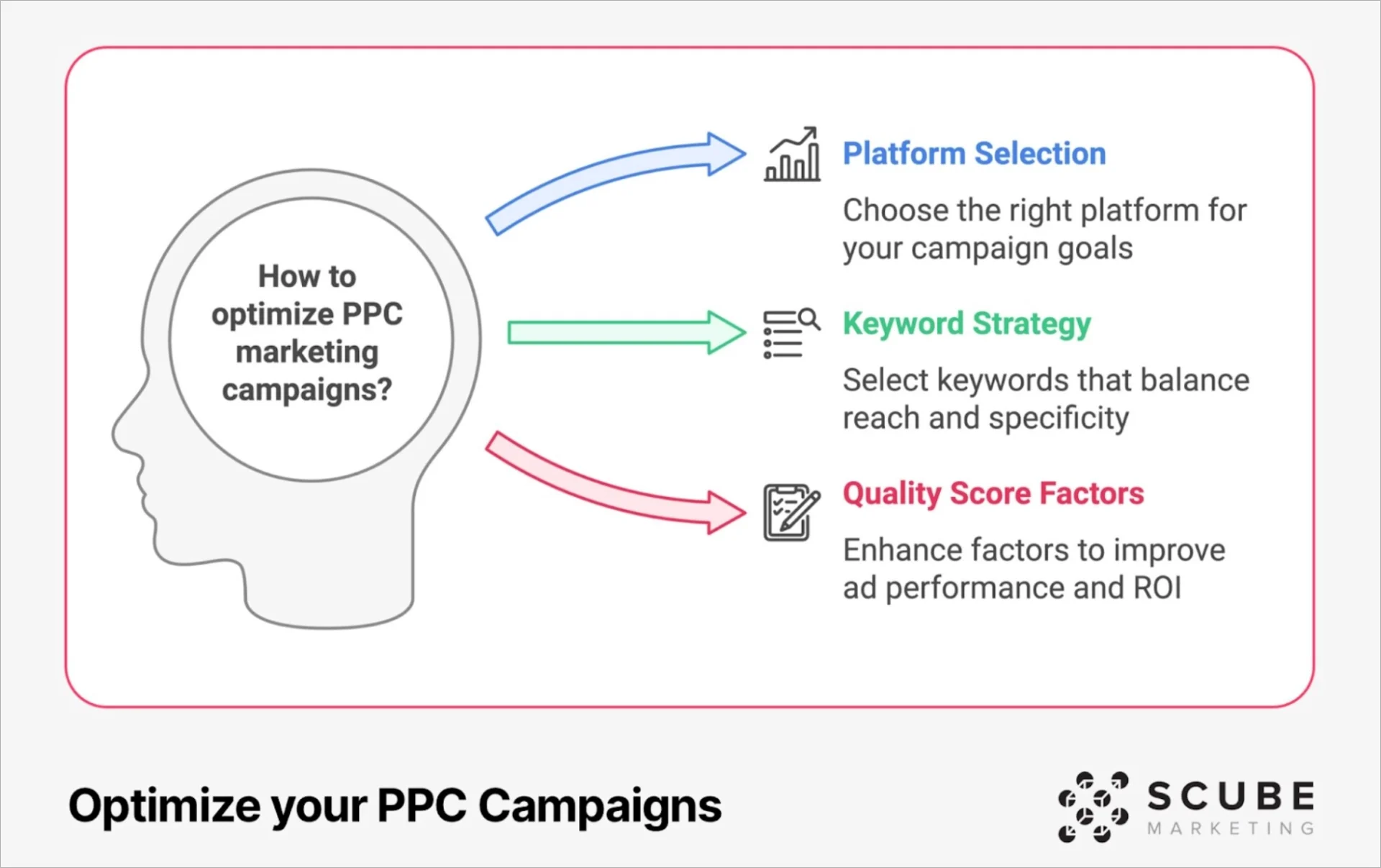
Objective
PPC aims to drive qualified visitors to your site by placing paid ads in front of the right audience.
Tactics
Use platforms like Google Ads, Facebook Ads, and LinkedIn Ads to run targeted campaigns. Ads can be based on keywords, interests, location, or behavior. They may show in search results, newsfeeds, or across websites as banners or videos.
Success Factors
Good results depend on choosing strong keywords, targeting the right audience, and writing clear, persuasive ads. Your landing page should match the ad’s message and guide users to take action. Keep testing and adjusting bids, copy, and targeting to improve over time.
Measurement
Key metrics in PPC include click-through rate, cost per click, conversions, quality score, and return on ad spend. These show whether your ads are reaching the right people and making an impact.
Sending traffic to your homepage? Time to fix that. Discover why landing pages convert better.
5. SEM
Search engine marketing (SEM) improves your website’s visibility in search results using both paid and organic methods. It combines SEO and PPC to increase exposure and drive more traffic from search engines like Google and Bing.

Objective
SEM aims to boost your presence on search engines by using both paid ads and unpaid strategies together.
Tactics
Run PPC campaigns targeting high-intent keywords while improving your site’s SEO for lasting organic traffic. Use Google Ads for quick results and optimize your website for long-term search rankings. The mix helps you cover both short- and long-term goals.
Success Factors
Strong SEM depends on choosing the right keywords and tracking performance regularly. You need to balance your budget between paid ads and SEO work. Keep adjusting your ads and updating your content to stay ahead of search trends.
Measurement
Measure SEM success by combining SEO and PPC data. Look at organic traffic, rankings, ad click-through rates, cost per click, and conversion rates. These numbers show how your paid and organic efforts work together.
Paid ads get traffic. Landing pages get results. See how to turn your SEM spend into real leads.
6. Social Media Marketing
Social media marketing promotes your business through platforms like Facebook, Instagram, LinkedIn, and TikTok. It helps you build direct connections, share content, and increase brand visibility through both organic posts and paid ads.
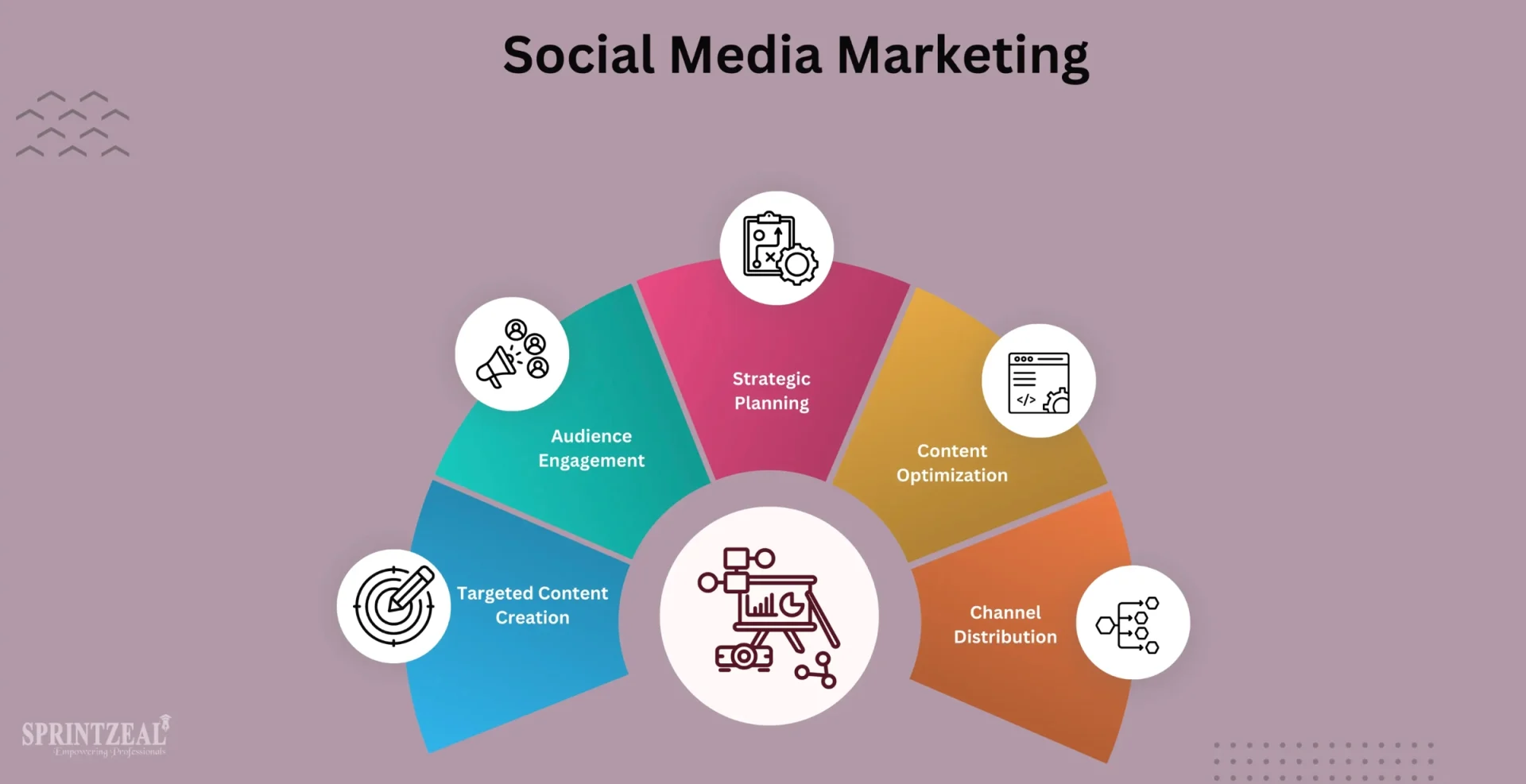
Objective
The goal of social media marketing is to grow brand awareness, interact with your audience, and drive traffic or sales through social platforms.
Tactics
Create and share posts, stories, short videos, and paid ads tailored to each platform. Engage with users through comments, replies, and direct messages. Use each platform’s strengths – visuals on Instagram, conversations on Twitter, or B2B content on LinkedIn.
Success Factors
Know where your audience spends time and what content they engage with. Post regularly, stay on-brand, and respond to your followers. Use paid promotions to reach a wider audience or support specific goals like lead generation.
Measurement
Track follower growth, post engagement, reach, and clicks to your site. For paid efforts, watch metrics like click-through rate, cost per acquisition, and return on ad spend to understand campaign performance.
Turn social buzz into conversions. Learn how personalized landing pages can supercharge your social media campaigns.
7. Influencer Marketing
Influencer marketing means working with people who have loyal online followings to promote your brand or product. These creators already have the trust of their audience, which helps your message feel more personal and credible.
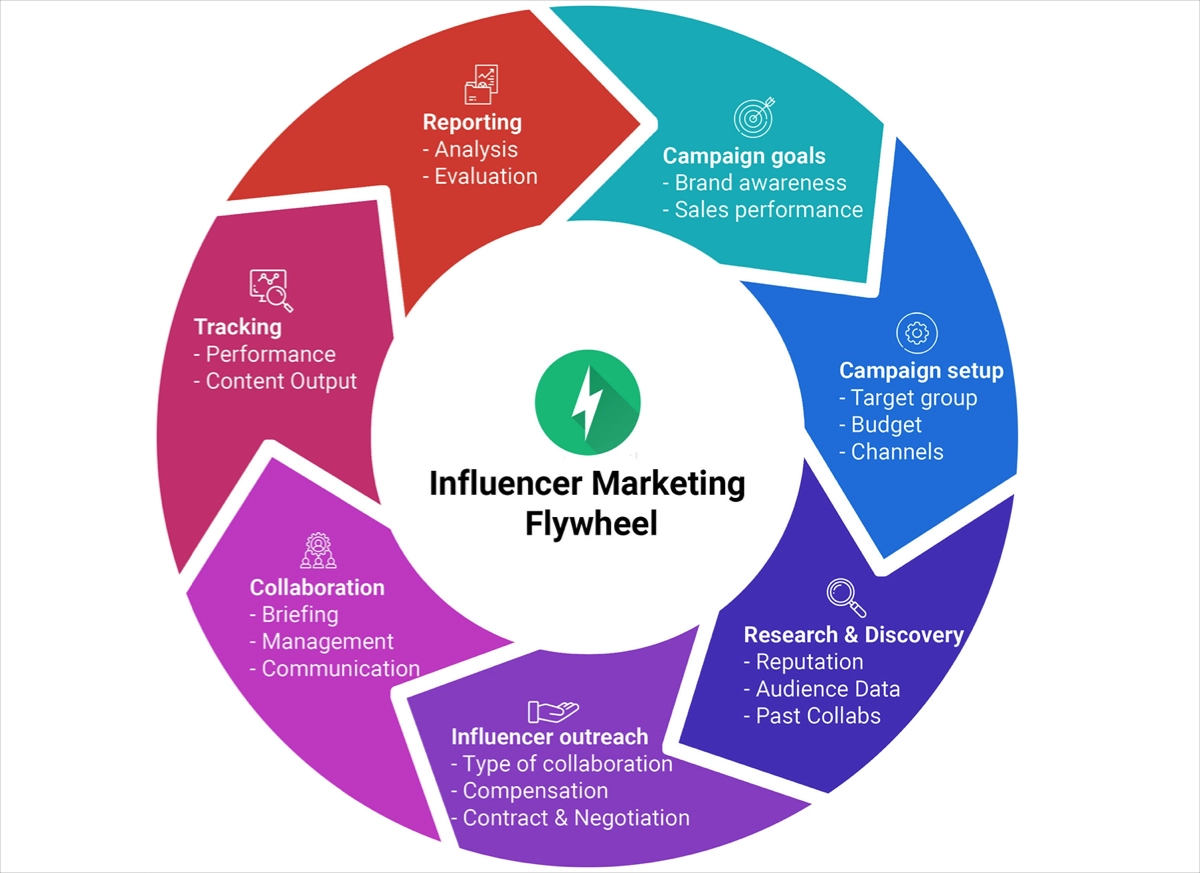
Objective
The main goal is to boost awareness and sales by sharing your brand through trusted voices your audience already follows.
Tactics
Find influencers whose followers match your target audience. Collaborate on sponsored posts, product reviews, or giveaways. Let influencers create the content in their own voice so it feels natural and genuine to their followers.
Success Factors
The success of influencer marketing depends on choosing influencers who align with your brand and have real engagement, not just a large following. Long-term partnerships often lead to better results than one-time posts, as they build familiarity and trust over time.
Measurement
Track likes, shares, comments, brand mentions, and referral traffic. Use custom links or discount codes to measure direct sales and conversions from each influencer.
8. CRO (Conversion Rate Optimization)
CRO helps increase the number of visitors who take action on your website, like signing up or buying something. It focuses on improving your site’s design, content, and user experience to guide more people toward conversion.
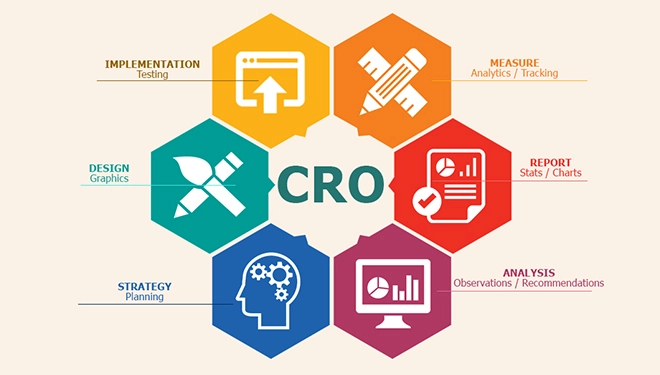
Objective
The goal of CRO is to raise the percentage of users who complete actions that matter to your business.
Tactics
Start by studying how people use your site. Identify where they drop off or hesitate. Improve elements like page layout, headlines, call-to-action buttons, forms, and loading speed. Make small, data-based changes and test them over time.
Success Factors
Effective CRO depends on clear insights into user behavior. Regular A/B testing helps you learn what works best. Even small improvements (like changing button text or form placement) can increase results when backed by data.
Measurement
Key metrics include conversion rate, bounce rate, time on page, and user flow through your site. Use tools like Google Analytics, Hotjar, or Crazy Egg to watch how people interact with your pages.
It’s not just traffic that matters—it’s what people do once they land. See how better text and testing inside Landingi drive action.
9. Omnichannel Marketing
Omnichannel marketing delivers a connected experience across every platform your customer uses – online and offline. It ensures that no matter where someone interacts with your brand, the messaging and experience feel consistent and smooth.
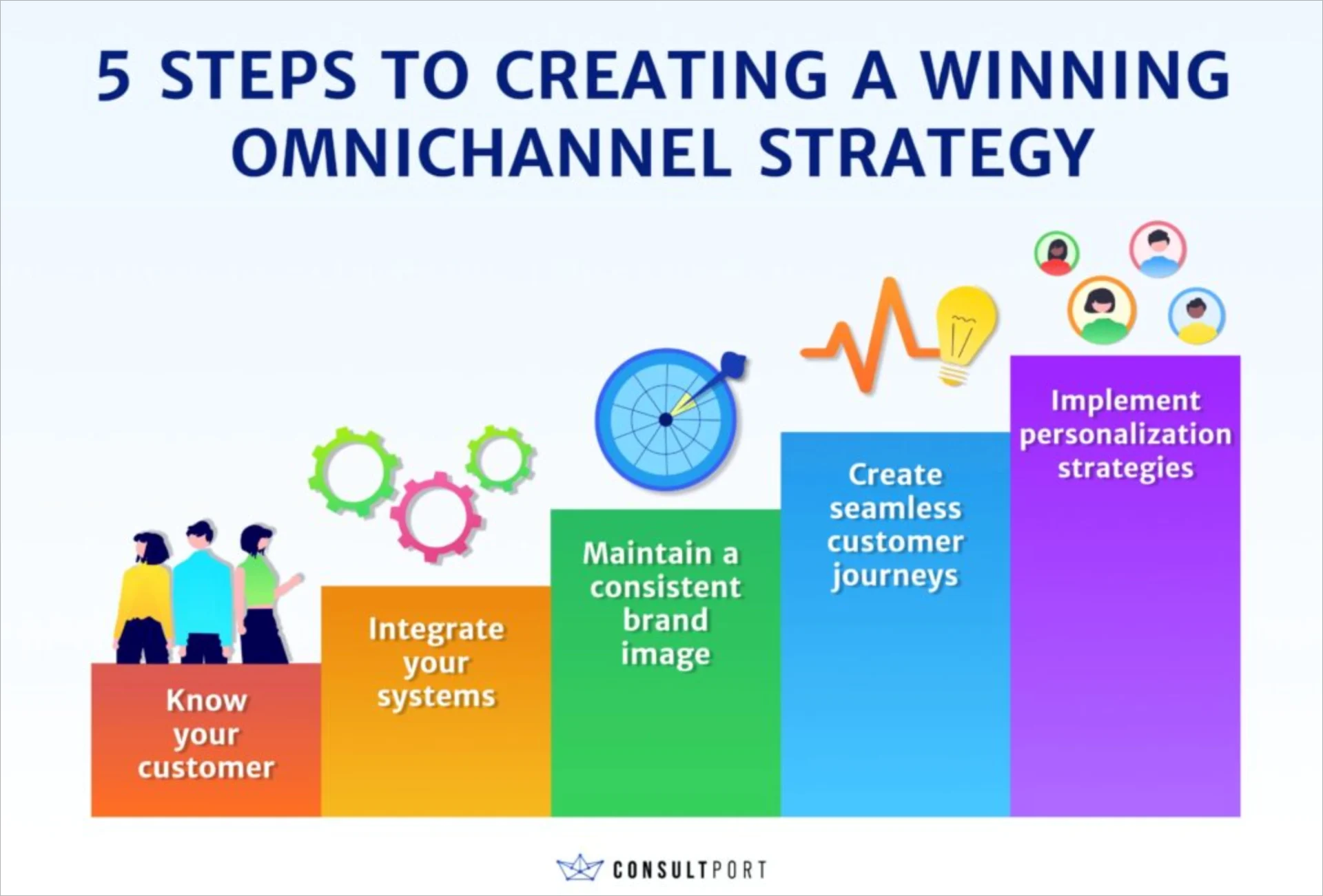
Objective
The goal is to create a unified journey across all touchpoints (email, social media, website, mobile, and in-store) to build trust and loyalty.
Tactics
Coordinate your messaging across platforms. Use tools that track customer behavior and personalize offers, emails, or ads based on their activity. A user might see a product online, get a follow-up email, and then visit a store to buy – all as part of one connected experience.
Success Factors
Consistency is key. Every channel should reflect the same message and branding. Use unified customer data so each platform “knows” the customer. This allows people to move between channels without friction or confusion.
Measurement
Track customer lifetime value, repeat purchase rate, and engagement across channels. Tools like CRMs or customer data platforms help combine data from different sources to measure how well your strategy is working.
Add landing pages to guide customers smoothly through every step of their journey.
6 Digital Marketing Strategy Best Practices and Tactics
Best practices and tactics for digital marketing strategies include data-driven decision-making, content marketing with SEO integration, personalization & segmentation, omnichannel marketing, mobile optimization, and social media engagement & community building. Read on to learn more about digital marketing tactics and practices you should consider incorporating into your online marketing strategy.
1. Use Data for Decision Making
Effective marketing starts with data. Use it to guide your strategy, not just report results. Look at customer behavior, web traffic, and campaign metrics to make smarter decisions. Metrics like click-through rates, conversion rates, and bounce rates show what’s working and what’s not. This helps you spend time and budget where it matters most.
Track your campaigns using tools like Google Analytics. Set specific goals – for example, newsletter signups or purchases – and monitor them weekly. This allows you to spot trends and catch underperforming channels early. Shift more budget to the channels that show results, and pause the ones that don’t.
A/B testing is another valuable tool. Test two versions of your ad or landing page with slight changes, like the headline or call-to-action. See which one gets more conversions, and use that insight to improve your next campaign. Don’t guess – let the data show you what your audience responds to.
Use the “Acquisition” report in Google Analytics to find out where your traffic comes from. You’ll see how much comes from search, social, paid ads, or email. Spend more on the channels that bring in quality traffic, and revise or cut the ones that don’t perform.
Small changes based on clear data can lead to better results over time. Stay consistent with tracking, review your results often, and keep testing new ideas.
2. Optimize Content with SEO Integration
To increase your visibility online, your content must be optimized for search engines. This means using relevant keywords, building backlinks, and making your site easy to use on mobile devices. These steps help search engines understand your content and show it to the right people.
Start by finding five long-tail keywords related to your topic. Use tools like Ahrefs, Ubersuggest, or Google Keyword Planner. Focus on keywords that have clear intent and moderate competition. Each week, write one blog post centered on a specific keyword.
Make sure the keyword appears in your title, URL, H1, meta description, and image alt tags. This tells search engines exactly what your post is about and improves your chances of ranking. Don’t overuse the keyword – write naturally and keep your content helpful.
Create a content calendar to stay consistent. Plan one blog post per week for the next three months. Keep your topics relevant to your audience’s questions and search habits.
After publishing, use a tool like SEMrush or Google Search Console to track your keyword rankings. This helps you measure progress and adjust your strategy. SEO takes time, but steady effort brings long-term results. Keep refining based on what performs well.
3. Personalize and Segment Your Audience
Personalized marketing increases engagement by speaking directly to each customer’s needs and behavior. Segment your audience using data like demographics, browsing habits, or past purchases. This helps you send more relevant content that actually gets read.
Start by dividing your email list into smaller groups in tools like Mailchimp or HubSpot. For instance, create a segment for people who recently bought a product. Build a short email series for them, offering a related item, an upsell, or a discount. Keep the timing tight – send the first message within a few days of purchase.
Find your most valuable customer groups, such as frequent buyers or those with high order values. Within the next 30 days, send each segment a personalized offer based on what they’ve already purchased. This shows customers you’re paying attention and improves repeat sales.
See how users interact with your landing pages in real time. Use data to deliver offers that feel tailor-made (because they are).
4. Implement Omnichannel Marketing
Consistent messaging across channels helps people remember and trust your brand. Omnichannel marketing connects your emails, social posts, ads, and website so the experience feels seamless to the customer.
Use a tool like Hootsuite to schedule posts about a new product across Instagram, Facebook, and LinkedIn. At the same time, send an email with the same message and run a Google Ads retargeting campaign. When people see the same message in multiple places, they’re more likely to act.
For your next campaign, create a single message and adjust it slightly for each platform. Launch all parts (social posts, ads, and emails) on the same day. Keep the tone, offer, and visuals consistent.
5. Optimize for Mobile Users
With more than 50% of internet users browsing on their phones, your site must work well on mobile devices. A slow or clunky mobile site turns visitors away. Fast loading times, a clean layout, and easy navigation keep users engaged and reduce bounce rates.
Start by testing your site using Google’s Mobile-Friendly Test. This will show if your pages are responsive and load quickly. If not, adjust your CSS, compress images, and streamline page elements. Sticky navigation buttons also help users move around more easily on smaller screens.
Use Google Analytics to find the three pages with the highest mobile bounce rate. Focus on improving those pages first. Cut down load times, simplify forms, and make buttons easy to tap. Mobile users expect quick and smooth experiences – meet that standard to keep them on your site.
6. Engage and Build Communities on Social Media
Social media is about connection, not just broadcasting. To build a real community, talk with your audience – don’t just talk at them. Reply to comments, ask open-ended questions, and post interactive content like polls, quizzes, or live videos.
A great way to start is by hosting a monthly live Q&A on Instagram or Facebook. Answer questions in real time and call out users by name. This shows you’re listening and encourages more people to take part.
Promote the live session one week before it happens. Send a reminder email and post updates the day before. Come prepared with five to seven FAQs to start the discussion, and invite viewers to ask more during the session.
Real engagement builds trust, loyalty, and stronger brand recall. Stay active, stay human, and your audience will stay with you.
How to Create Effective Digital Marketing Strategy in 8 Steps?
To create an effective digital marketing strategy, start by defining your business goals, understanding your audience, and studying your competitors to find marketing opportunities. Then, review your current digital presence, plan your content, pick the right channels, assign resources wisely, and keep improving through regular performance checks.
Follow these eight steps to build a strategy that drives results and helps you stand out in a crowded market.
Step 1. Define Your Business Goals
Begin by setting clear business goals. These goals give direction to everything you do in marketing. Without clear goals, it’s hard to measure success or decide where to focus.
Choose goals that make sense for your business. You might want to increase traffic, boost sales, get more leads, or grow brand awareness. Use the SMART framework – goals should be Specific, Measurable, Achievable, Relevant, and Time-bound.
Make sure your marketing goals match your overall business plans. For example, if you’re entering a new market or launching a product, your marketing should support that.
Here are two strong goal examples:
- “Increase organic traffic by 30% in the next six months.”
- “Generate 100 new leads per month through PPC campaigns.”
These kinds of goals give your team focus and a way to track progress.
Step 2. Identify Your Target Audience
Know exactly who you’re speaking to. Understanding your audience lets you create messages that connect and convert. If you skip this step, your marketing might miss the mark entirely.
Build detailed profiles of your ideal customers, known as buyer personas. These should cover basic info like age, job title, and location. Go deeper by looking at their online habits, pain points, and what influences their decisions.
Use real data to shape these personas. Tools like Google Analytics, social media insights, and customer surveys can show patterns in behavior and interests. Aim to create more than one persona if your audience has different segments.
Step 3. Conduct a Competitive Analysis
Study your competitors to learn what they do well and where they fall short. This gives you a clear idea of how to position yourself.
Start by choosing three to five competitors in your space. Review their websites, social media pages, and online ads. Pay attention to how they speak to their audience and what offers they promote.
Use tools like SEMrush or Ahrefs to uncover keywords they rank for and ads they run. Check which content formats perform best for them – are they investing in blog posts, videos, or infographics?
Identify gaps in their strategies. For example, they might lack video content or ignore certain platforms. These gaps are chances for you to stand out.
Step 4. Perform an Audit of Your Current Digital Presence
Start with a full review of your existing digital channels. This helps you see what’s working and what needs fixing. Without this step, you risk building on an unstable foundation.
Check your website performance using tools like Google Analytics. Focus on metrics like bounce rate, traffic sources, time on page, and conversions. These numbers reveal how users interact with your site and where they drop off.
Audit your SEO using tools such as Moz or Screaming Frog. Look for broken links, missing tags, and keyword gaps. Fixing these issues can improve visibility and rankings.
Next, assess your social media and email marketing. See which platforms bring the most traffic or engagement. Look at open rates, click-through rates, and subscriber growth. These metrics show what content your audience finds useful.
Step 5. Develop a Content Strategy
Plan your content so it speaks to your audience and supports your business goals. A solid strategy makes your content more effective and easier to manage, saving time and increasing your reach.
Decide what formats to use: blog posts, videos, infographics, or podcasts. Pick based on what your audience prefers and where they spend time. Use a content calendar to stay organized and publish consistently.
Do keyword research before you create anything. This helps your content show up in search and attract the right people. Tools like Ubersuggest or Google Keyword Planner can help.
Don’t let your content live in just one place. Re-use it in different formats. For example, a blog post can become a short video or a carousel for social media.
Step 6. Choose the Right Digital Marketing Channels
Pick the platforms that match your audience and goals. Not every channel fits every business, so be selective.
Start by identifying where your audience spends their time. If you’re selling to professionals, LinkedIn often works well. For visual products, Instagram or Pinterest may deliver better results. If your focus is engagement or community building, consider Facebook or Twitter.
Think about the return on investment. Use Google Ads for quick traffic and visibility. Invest in SEO to grow long-term traffic without ongoing ad spend. Use email marketing to build lasting relationships and move leads closer to purchase.
Step 7. Allocate Your Budget and Resources
Distribute your budget wisely across your marketing efforts. Poor allocation leads to weak campaigns and wasted time. Smart resource planning keeps your strategy moving forward without burning out your team or draining your budget.
Break your budget into key areas: paid ads, SEO, content, social media, and tools. For example, you may spend more on ads early on, then shift focus to SEO as your strategy matures.
If you’re working with a small team, outsource what you can’t handle in-house. Platforms like Fiverr or Upwork offer affordable help for tasks like writing or design.
Leave some budget aside for testing and changes. You’ll need flexibility to double down on what works or fix what doesn’t.
Step 8. Measure and Optimize
Track your results regularly to make sure your strategy is delivering. Without measurement, you can’t improve or scale your efforts.
Use tools like Google Analytics, Facebook Insights, or your email platform to monitor performance. Focus on metrics that match your goals, like traffic, engagement, conversions, or cost per click.
Set clear KPIs for each channel. For SEO, track keyword rankings and organic traffic. For PPC, measure cost per acquisition. This makes it easier to see what’s working and where to adjust.
Review your data weekly or monthly. Look for patterns and areas of improvement. Run A/B tests on ads, landing pages, or email subject lines to fine-tune your results.
4 Successful Examples of Digital Marketing Strategy
Digital marketing strategies work best when they connect with people through emotion, data, and timely content. Nike, Coca-Cola, Spotify, and Airbnb each show how different approaches can lead to strong engagement and visibility on a global scale. Their success lies in combining storytelling, personalization, and smart use of platforms.
1. Nike’s Digital Strategy: Connecting Emotion with Innovation
Nike builds campaigns that connect deeply through emotional storytelling and real-time digital content.
The “Dream Crazier” campaign celebrated female athletes and shared their stories across video and social media. Nike used influencer partnerships to amplify this message and connect with a wide audience. The content focused on resilience, strength, and personal achievement, which helped viewers feel personally involved.
Nike also launched the “Breaking2” project, where elite runners attempted to finish a marathon in under two hours. This campaign blended science, sport, and teamwork to create an inspiring digital experience. Nike published updates and videos in real time, keeping fans invested in the story as it unfolded.
Both efforts used social media, video, and influencer support to grow engagement and build emotional loyalty. These campaigns helped position Nike as a brand that supports both personal ambition and community values.
2. Coca-Cola’s Personalization Strategy: Turning Customers into Advocates
Coca-Cola’s strategy shows how personal touches can build emotional ties and inspire people to share online.
The “Share a Coke” campaign replaced the brand’s logo with popular first names on bottles. This simple change made the product feel personal and shareable. People began posting photos and stories with their named bottles, creating a wave of user-generated content on social media.
Coca-Cola supported the campaign with targeted digital ads and location-based messaging. Data analytics helped the brand identify which names and regions to focus on. This approach increased relevance while keeping the message consistent across global markets.
By blending personalization with data insights, Coca-Cola created a campaign that felt local, personal, and emotionally engaging – at scale.

3. Spotify’s Data Strategy: Using Personalization to Boost Retention and Sharing
Spotify uses data to create experiences that feel unique to each listener, helping people stay engaged and loyal.
The “Only You” campaign turned listening habits into custom playlists and visual summaries. Users saw detailed insights about their music preferences, like time-of-day habits or unexpected artist pairings. This content felt personal and fun to share, which encouraged social media activity.
Spotify designed the campaign to spark word-of-mouth through visuals that users could post easily. It also helped people explore more music through customized recommendations. These features gave users a reason to return often and explore deeper.
Spotify’s success came from using data not just to recommend songs, but to make people feel seen and understood.

4. Airbnb’s SEO Strategy: Using Content to Drive Organic Growth
Airbnb grew its global presence by combining helpful content with strong search engine optimization.
The platform offered travel tips, city guides, and host advice – content that users searched for regularly. This helped Airbnb rank high in search results and attract steady traffic without paid ads. It also made the site more useful for both hosts and travelers.
Airbnb encouraged users to share reviews, stories, and photos. This user-generated content added fresh keywords and built trust with future guests. The company also used data to recommend listings and guide users to relevant content.
By making content useful and easy to find, Airbnb turned search traffic into long-term users and bookings.

How to improve digital marketing strategy?
To improve your digital marketing strategy, start by using your data. Review performance metrics to see what’s working and what’s falling short. Adjust your campaigns based on these insights, not assumptions. Run A/B tests regularly (on ads, emails, landing pages) to sharpen your message and improve conversions. Keep optimizing based on real feedback, not guesswork.
What is the most effective digital marketing strategy?
The most effective strategy combines content marketing, search engine optimization, and paid advertising. This mix helps you cover both organic and paid channels. The exact balance depends on your audience and business goals. What matters most is staying consistent and measuring results as you go.
What are the limitations of digital marketing strategies?
Digital marketing has limits. There’s too much content online, and people tune out ads quickly. Algorithms shift often, and that can cut your reach overnight. It also takes time and money before you see strong results. Be ready for a long-term effort.
What is the best digital marketing strategy for small business?
The best digital marketing strategy for small businesses is content marketing, local SEO, and active social media use. These tools don’t require huge budgets and help you connect directly with nearby customers. Publishing helpful content builds trust and keeps people coming back.
What is the best digital marketing strategy for a brand?
For brand growth, use a mix of influencer outreach, social media content, and storytelling. Focus on creating engaging posts that reflect your voice and values. Trust grows when people see consistency and authenticity from your brand across channels.
What is the best digital marketing strategy for beginners?
If you’re just starting digital marketing, begin with content and social media. Write helpful posts or videos about your niche. Share them consistently. These platforms are simple to use and give you feedback fast. As you learn more, expand into other strategies like email or ads.
Where to find best digital marketing plan template?
Check out templates on HubSpot, CoSchedule, or Smartsheet. They guide you through every step: goals, tactics, timelines, and measurement. Pick one that fits your business type, then tweak it as you grow.
Build Digital Strategies That Convert with Landing Pages That Perform
A strong digital strategy should focus on your audience, not just the channels. SEO, content, and paid ads only work if your message meets your customers’ needs. The best way to test that? Create landing pages that match what people are searching for or clicking on. Use real data to adjust your offers, layouts, and messages until you see results.
Tools like Landingi help make this easy. It’s a landing page builder that doesn’t need coding. You can use its drag-and-drop editor, update reusable elements with Smart Sections, and run A/B tests to see what works best. It connects with over 180 apps and lets you publish pages wherever you need. That means fewer bottlenecks, faster updates, and more control over your performance.
When your landing pages perform well, your entire marketing strategy works better. You spend less to get more results. Try Landingi for free and see how quickly you can build pages that turn clicks into real growth.






